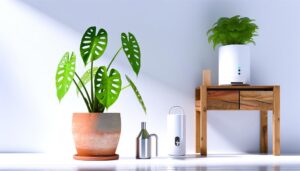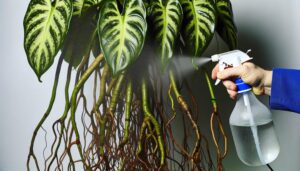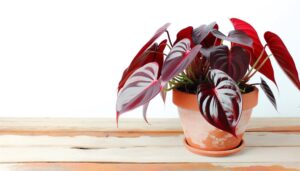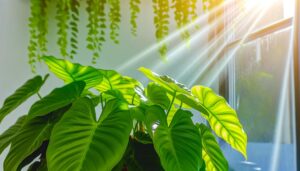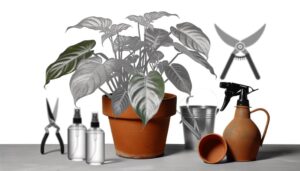What Are the Care Requirements for a Philodendron Neon Cordatum?
The Philodendron Neon Cordatum thrives under bright, indirect light, avoiding direct sunlight to prevent leaf burn. Adequate watering requires moist, not saturated, soil with intervals allowing the top inch to dry.
It flourishes in a well-draining, peat-based potting mix and requires periodic fertilizing with a balanced 20-20-20 formulation. Essential growth considerations include suitable pot and plant size, managing light overexposure, and disease resistance.
Familiarity with its habitat of origin, the Central and South American rainforests, gives further insights into its natural growing conditions. For those interested, there's more to learn about advanced care, such as dealing with potential pests and diseases.
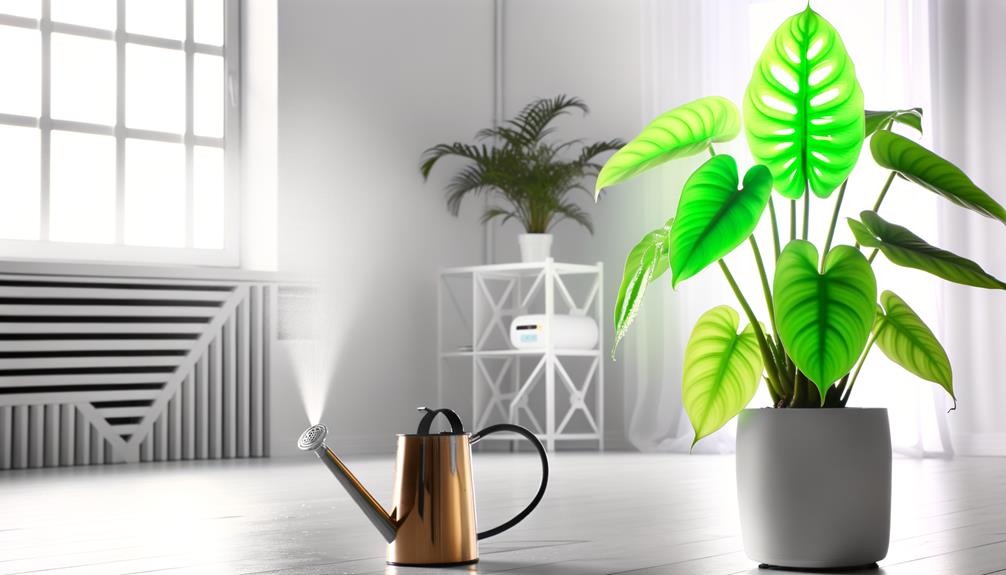
Key Takeaways
- The Philodendron Neon Cordatum thrives in bright, indirect light, avoiding direct sunlight to prevent leaf burn.
- It requires moist soil and should be watered approximately once a week, allowing the top inch of soil to dry between watering.
- The plant thrives in a well-draining, peat-based potting mix, ideally 2 parts peat to 1 part perlite.
- Fertilize the plant monthly with a balanced 20-20-20 fertilizer, diluted to half strength to avoid root burn.
- The Philodendron Neon Cordatum should be repotted every 2-3 years or when it outgrows its current pot.
Understanding Philodendron Neon Cordatum

Commonly used in indoor landscaping, the Philodendron Neon Cordatum is a tropical plant species that is renowned for its vibrant, heart-shaped leaves and its ability to thrive in a wide range of indoor environments.
Originating from the tropical rainforests of Central and South America, it is a part of the Araceae family, an extensive group of flowering plants. This epiphytic variety grows on the surface of other plants, deriving nutrients and moisture from the air, rain, or debris accumulating around it. It's a climber that can reach up to 3 meters in height.
The leaves, reminiscent of a heart in structure, exhibit an enticing neon green color, adding an invigorating touch to any interior space. Effective care enhances its growth, longevity, and aesthetic appeal.
Ideal Lighting Conditions
The Philodendron Neon Cordatum thrives ideally under specific lighting conditions. It is essential to comprehend the light needs of this plant to maintain its radiant neon green color and promote healthy growth.
Equally important is learning how to prevent light overexposure, as this could potentially lead to leaf scorching or other detrimental effects.
Understanding Light Needs
For peak development, the Philodendron Neon Cordatum thrives under indirect, bright light conditions, a vital factor that contributes significantly to its vibrant hue and overall health.
- Positioning: Avoid placing the plant in direct sunlight, as it can cause leaf burn. The ideal location is near a north or east-facing window, where it will receive plenty of diffused light.
- Artificial Lighting: Fluorescent lights can be an effective alternative if natural light is insufficient. Ensure the light source is close enough to mimic the intensity of natural light, but not so close as to cause heat stress.
- Seasonal Changes: Be mindful of seasonal light variations. As the intensity and duration of daylight changes, adjust the plant's position or lighting source accordingly to maintain optimal light conditions.
Preventing Light Overexposure
Despite their affection for bright light, Philodendron Neon Cordatum plants are vulnerable to overexposure, which can lead to phototoxicity or light-induced damage. This can be prevented by monitoring the plant's exposure to direct sunlight.
Ideally, these plants thrive in bright, indirect light, or in a shaded spot with filtered sunlight. Overexposure can be identified by the presence of yellow or brown patches on the leaves. If such symptoms appear, it is recommended to move the plant to a more suitably lit area.
Additionally, using a light meter can help identify the ideal light intensity for your Philodendron Neon Cordatum. This scientific approach can assist you in maintaining the best photosynthetic activity in the plant, thereby promoting its overall health and growth.
Watering Your Neon Cordatum
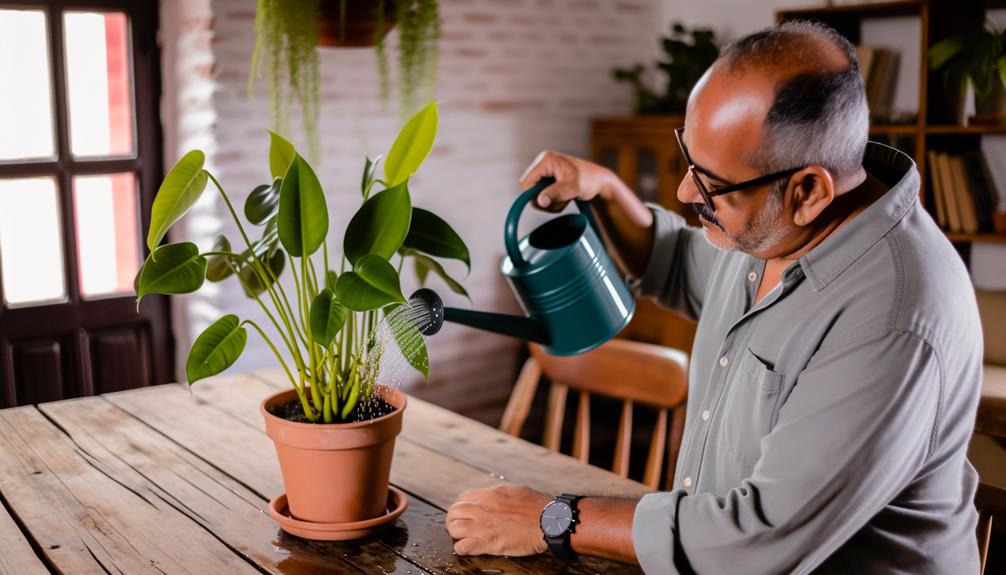
While the Philodendron Neon Cordatum is relatively low-maintenance, it is essential to understand that proper watering, specifically a regime that mimics its natural, tropical environment, plays a significant role in its overall health and growth.
Here are some key watering considerations:
- Frequency: This plant thrives in moist soil conditions. Watering should be done approximately once a week. However, keep in mind that overwatering can cause root rot. Hence, it's imperative to allow the top inch of soil to dry out between watering sessions.
- Water Quality: Use lukewarm, distilled, or rainwater for best results. Minerals in tap water can build up in the soil and harm the plant.
- Humidity: Neon Cordatum requires high humidity. Regularly misting the leaves can replicate the humid conditions of its native habitat and promote robust growth.
Proper Soil and Potting Needs
The suitability of soil and the adequacy of potting methods can greatly influence the health and vibrancy of a Philodendron Neon Cordatum. This tropical plant thrives in well-draining, peat-based potting mix. A good proportion would be 2 parts peat and 1 part perlite. This combination guarantees proper drainage, preventing root rot and promoting healthy root development.
As for potting, the Neon Cordatum requires a pot with ample drainage holes. A too-small pot may restrict root growth, while an excessively large one can lead to waterlogging. A pot of appropriate size, relative to the plant's current size, should be selected.
Repotting should occur every 2-3 years, or when the plant outgrows its pot. These are integral aspects of caring for the Philodendron Neon Cordatum.
Fertilizing and Growth Tips
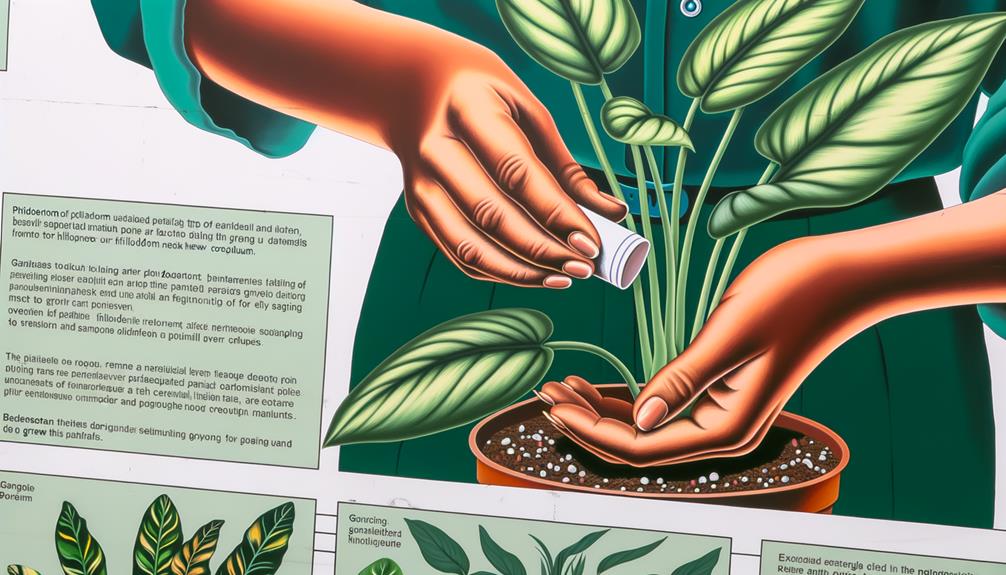
Understanding the correct fertilization process is crucial in nurturing a Philodendron Neon Cordatum to its full potential. This plant thrives when nourished with a balanced, water-soluble houseplant fertilizer.
- Frequency: Fertilize once a month during the growing season, typically March to October. In winter, reduce to every 6-8 weeks.
- Ratio: Use a balanced 20-20-20 fertilizer, that is, 20% Nitrogen, 20% Phosphorous, and 20% Potassium. This guarantees the plant has the essential nutrients for growth, photosynthesis, and disease resistance.
- Application: Dilute the fertilizer to half the recommended strength to avoid root burn. Water the plant thoroughly before and after application to make sure nutrients are evenly distributed.
Following these tips diligently will result in a lush, neon-green Philodendron with healthy growth.
Dealing With Potential Pests and Diseases
Despite the Philodendron Neon Cordatum's relative hardiness, it is not entirely immune to common houseplant pests and diseases, requiring vigilant care and attention. The most common pests include mealybugs, spider mites, and scale insects, which can be treated using neem oil or insecticidal soap. It's essential to isolate infected plants to prevent the spread of pests.
Diseases such as root rot and leaf spot can be prevented by ensuring proper watering and humidity levels. Root rot, a result of overwatering, can be mitigated by using well-draining soil and pots. Leaf spot, caused by fungal or bacterial infections, can be prevented by maintaining good air circulation. Always remove and dispose of any infected leaves to prevent further spread of the disease.
Conclusion
To sum up, the Philodendron Neon Cordatum's care needs are undeniably manageable, making it a delightful addition to any indoor garden. By offering adequate lighting, watering, soil, fertilizing, and pest control, this vibrant variety will thrive.
Its radiant appeal and minimal upkeep make it a sought-after option for both beginner and skilled gardeners. Grasping and executing these care needs can guarantee a flourishing Philodendron Neon Cordatum, enhancing the visual charm of any indoor area.

